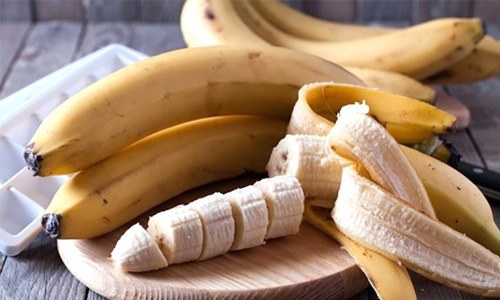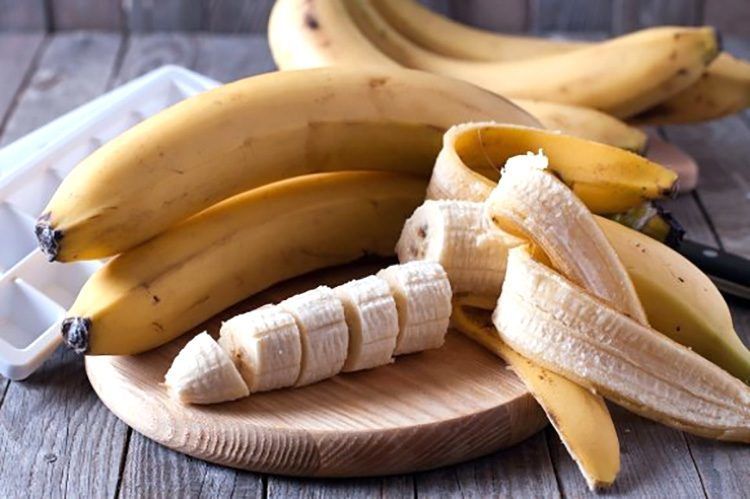

Bananas are extremely healthy and delicious.
They contain several essential nutrients and have benefits for digestion, heart health and weight loss.
Aside from being very nutritious, they are a highly convenient snack food.
Here are 11 health benefits of bananas that are supported by scientific research.
1. Bananas Contain Many Important Nutrients
Bananas are among the most popular fruits on Earth.
Native to Southeast Asia, they are now grown in many warmer parts of the world.
There are many types of bananas available, which vary in color, size and shape. The most common type is the yellow banana, which is green when unripe.
This is what ripe bananas typically look like:
Bananas contain a fair amount of fiber, as well as several antioxidants. One medium-sized banana (118 grams) also contains (1, 2, 3):
- Potassium: 9 percent of the RDI.
- Vitamin B6: 33 percent of the RDI.
- Vitamin C: 11 percent of the RDI.
- Magnesium: 8 percent of the RDI.
- Copper: 10 percent of the RDI.
- Manganese: 14 percent of the RDI.
- Net carbs: 24 grams.
- Fiber: 3.1 grams.
- Protein: 1.3 grams.
- Fat: 0.4 grams.
Each banana contains only about 105 calories and consists almost exclusively of water and carbs. Bananas contain very little protein and almost no fat.
The carbs in unripe (green) bananas consist mostly of starch and resistant starch, but as the banana ripens, the starch turns into sugar (glucose, fructose and sucrose).
Bottom Line: Bananas are rich in fiber, antioxidants and several nutrients. A medium-sized banana contains about 105 calories.
2. Bananas Contain Nutrients That Moderate Blood Sugar Levels
Bananas are rich in a fiber called pectin, which gives the flesh its structural form (4).
Unripe bananas contain resistant starch, which acts like soluble fiber and escapes digestion.
Both pectin and resistant starch may moderate blood sugar levels after meals and reduce appetite by slowing stomach emptying (5, 6, 7).
Furthermore, bananas also rank low to medium on the glycemic index, which is a measure (from 0–100) of how quickly foods increase blood sugar levels.
The glycemic value of unripe bananas is about 30, while ripe bananas rank at about 60. The average value of all bananas is 51 (8, 9).
This means that bananas should not cause major spikes in blood sugar levels in healthy individuals.
However, this may not apply to diabetics, which should probably avoid eating lots of well-ripened bananas and monitor their blood sugars carefully when they do.
Bottom Line: Bananas contain nutrients that can help moderate blood sugar levels after meals. They may also reduce appetite by slowing stomach emptying.
3. Bananas May Improve Digestive Health
Dietary fiber has been linked to many health benefits, including improved digestion.
A medium-sized banana contains about 3 grams of fiber, making bananas a fairly good fiber source (10).
Bananas contain mainly two types of fiber:
- Pectin: Decreases as the banana ripens.
- Resistant starch: Found in unripe bananas.
Resistant starch escapes digestion and ends up in our large intestine, where it becomes food for the beneficial gut bacteria (11, 12, 13).
Additionally, some cell studies propose that pectin may help protect against colon cancer (14, 15).
Bottom Line: Bananas are fairly rich in fiber and resistant starch, which may feed the friendly gut bacteria and help protect against colon cancer.
4. Bananas May Help With Weight Loss
No study has directly tested the effects of bananas on weight loss. However, bananas do have several features that should make them a weight loss friendly food.
For starters, bananas contain relatively few calories. An average banana contains just over 100 calories, yet it is also very nutritious and filling.
They are also rich in fiber. Eating more fiber from fruit and vegetables has repeatedly been linked with lower body weight and weight loss (16, 17, 18).
Furthermore, unripe bananas are packed with resistant starch, so they tend to be very filling and may reduce your appetite (19, 20).
Bottom Line: Bananas may help with weight loss. They are low in calories, high in nutrients and fiber and may have appetite-reducing effects.
5. Bananas May Support Heart Health
Potassium is a mineral that is essential for heart health, especially blood pressure control.
Yet despite its importance, most people are not getting enough potassium in their diet (21).
Bananas are a great dietary source of potassium. One medium-sized banana (118 grams) contains 9 percent of the RDI.
A potassium-rich diet can help lower blood pressure and people who eat plenty of potassium have up to a 27 percent lower risk of heart disease (22, 23, 24, 25).
Furthermore, bananas contain a decent amount of magnesium, which is also important for heart health (26, 27).
Bottom Line: Bananas are a good dietary source of potassium and magnesium, two nutrients that are essential for heart health.
6. Bananas Contain Powerful Antioxidants
Fruits and vegetables are excellent sources of dietary antioxidants and bananas are no exception.
They contain several types of potent antioxidants, including dopamine and catechins (1, 2).
These antioxidants have been linked to many health benefits, such as a reduced risk of heart disease and degenerative diseases (28, 29).
However, it is a common misunderstanding that the dopamine from bananas acts as a feel-good chemical in the brain.
In reality, dopamine from bananas does not cross the blood-brain barrier. It simply acts as a strong antioxidant instead of altering hormones or mood (2, 30).
Bottom Line: Bananas are high in several antioxidants, which may help reduce damage from free radicals and lower the risk of some diseases.
7. Bananas May Help You Feel More Full
Resistant starch is a type of indigestible carbohydrate found in unripe bananas, which functions sort of like soluble fiber in the body.
As a rule of thumb, you can estimate that the greener the banana is, the higher the amount of resistant starch it contains (31).
On the other hand, ripe (yellow) bananas contain lower amounts of resistant starch and total fiber, but proportionally higher amounts of soluble fiber.
Both pectin and resistant starch have been shown to have appetite-reducing effects and increase the feeling of fullness after meals (20, 32, 33, 34).
Bottom Line: Bananas contain high amounts of resistant starch or pectin, depending on ripeness. Both may reduce appetite and help keep you full.
8. Unripe Bananas May Improve Insulin Sensitivity
Insulin resistance is a major risk factor for many of the world’s most serious diseases, including type 2 diabetes.
Several studies have shown that 15–30 grams of resistant starch per day may improve insulin sensitivity by 33–50 percent, in as little as 4 weeks (35, 36).
Unripe bananas are a great source of resistant starch and may therefore help improve insulin sensitivity.
However, the reason for these effects is not well understood and not all studies agree on the matter (35, 37).
Bottom Line: Unripe bananas are a good source of resistant starch, which may improve insulin sensitivity. However, more research is needed.
9. Bananas May Improve Kidney Health
Potassium is essential for blood pressure control and healthy kidney function.
As a good dietary source of potassium, bananas may be especially beneficial for maintaining healthy kidneys.
One study in women showed that over 13 years, those who ate bananas 2–3 times per week were 33 percent less likely to develop kidney disease (38).
Other studies have found that those who eat bananas 4–6 times a week are almost 50 percent less likely to develop kidney disease, compared to people who don’t eat bananas (38, 39).
Bottom Line: Eating a banana several times a week may reduce the risk of kidney disease by up to 50 percent.
10. Bananas May Have Benefits for Exercise
Bananas are often referred to as the perfect food for athletes, largely due to their mineral content and easily digested carbs.
Eating bananas may help reduce exercise-related muscle cramps and soreness, which affect up to 95 percent of the general population (40).
The reason for the cramps is basically unknown, but a popular theory blames a mixture of dehydration and electrolyte imbalance (41, 42, 43).
However, studies have provided mixed findings about bananas and muscle cramps. Some find them helpful, while others find no effects (44).
That being said, bananas have been shown to provide excellent nutrition before, during and after endurance exercise (45).
Bottom Line: Bananas may help relieve muscle cramps caused by exercise. They also provide excellent fuel for endurance exercise.
11. Bananas Are Easy to Add to Your Diet
Not only are bananas incredibly healthy—they’re also one of the most convenient snack foods around.
Bananas make a great addition to your breakfast yogurt, cereal or smoothie. You can even use them instead of sugar in your baking and cooking.
Furthermore, bananas rarely contain any pesticides or pollutants, due to their thick protective peel.
Bananas are incredibly easy to eat and transport. They are usually well-tolerated and easily digested and simply have to be peeled and eaten.
It doesn’t get much easier than that.
This article was reposted from our media associate Authority Nutrition.
YOU MIGHT ALSO LIKE
7 Foods That Keep You From Overeating
What You Should Eat to Balance Your pH and Alkalize Your Body
15 Best Foods for Detoxing Your Body
5 Ways to Eat Healthy: What Big Food Doesn’t Want You to Know

 233k
233k  41k
41k  Subscribe
Subscribe 
